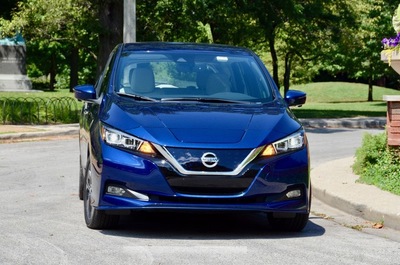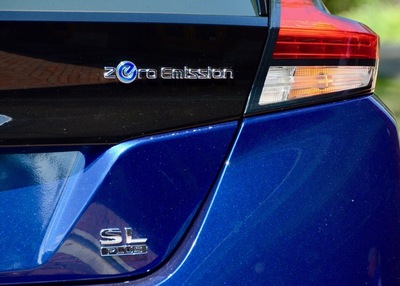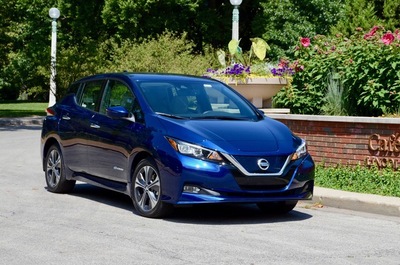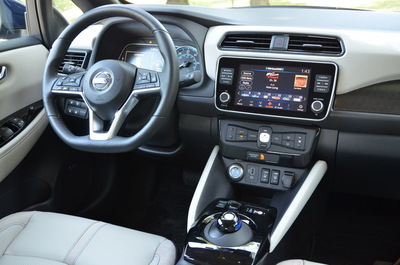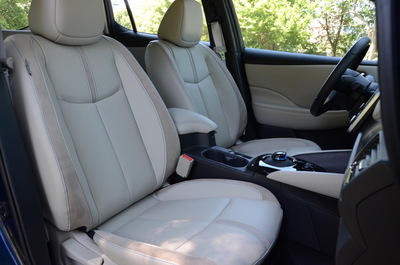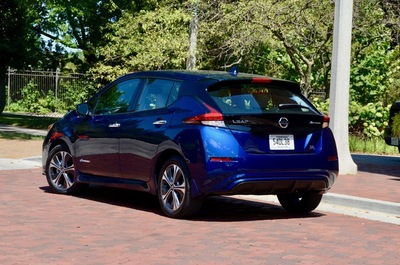Auto Channel Exclusive (ACE)-2019 Nissan Leaf Plus Review By Larry Nutson
2019 Nissan Leaf Plus
Going electric with confidence
By Larry Nutson
Senior Editor and Bureau Chief
Chicago Bureau
The Auto Channel
More often than not change comes about slowly. This is the case with the switch to battery-powered pure electric vehicles from the internal combustion engine type.
In general, the auto industry successfully brought electrification into new vehicles in the first decade of this century..the 2000s. This second decade, the one we are in right now, was expected to bring about a significant nationwide charging infrastructure. That happened, sort of, but not to the extent needed to make electric vehicles (EVs) more widely accepted.
Yes, driving range, range anxiety and higher EV cost were also some of the drawbacks. But for many the ability to recharge, or refuel if your will, was the biggest drawback. EVs work very well in slower speed urban, big city driving. Think of all those folks living in a high rise building who park their cars in a garage or, for many, on the street. How will they conveniently and easily recharge if they all drive and EV?
The auto makers are working on that. For example, Nissan and EVgo is installing 200 new 100kW DC fast charging stations in select U.S. markets. The expanded EVgo partnership will result in the largest installation of 100kW CHAdeMO quick chargers in the U.S. Nissan has invested more than $60 million in charging infrastructure for the benefit of owners of all types of electric vehicles
The joint investment by Nissan and EVgo is an expansion on a six-year partnership between two of the leaders in transportation electrification in the U.S. Nissan has installed more than 2,000 quick charge connectors across the country since 2010. So yes, it’s taken the entire decade to get some where with half-way decent charging infrastructure.
Nissan says more than 100 million Americans currently live within a 15-minute drive of an EVgo fast charger, including those built in partnership with Nissan along the I-95 corridor on the East Coast, and the DRIVEtheARC corridor in California from Monterey to Lake Tahoe.
More chargers are being installed by other automakers. And get this! Royal Dutch Shell is launching electric vehicle chargers at gasoline stations in Singapore. The electric vehicle charging service, ‘Shell Recharge’, will be available at 10 Shell gasoline stations in Singapore this year or about 20% of its retail network in the city-state, the company said in a statement. Will we start to see this happen in the U.S.? We’ll see.
I spent a few days driving around my Chicago home going about my usual business in a 2019 Nissan Leaf Plus. The 2019 Nissan Leaf Plus model is new for this year with a more powerful 214 horsepower motor and a 226-mile driving range. For comparison, the base LEAF has a 147 horsepower motor with an estimated driving range of 150 miles.
My Leaf Plus test car arrived just about fully charged with a 225 miles driving range displaying on the instrument cluster. I wasn’t concerned about recharging because less than a mile from my home is a Whole Foods store with two level-2 and one level-3 EVgo charger for customers. I’ve frequented this charging station in the past with other EVs and plug-in hybrids that I’ve driven.
A level-3 charger is the 440-volt fast charger. It will recharge an EV battery to 80-percent capacity in about 30 minutes. I drove the Leaf Plus down to 24-percent remaining battery charge and then plugged in at the Whole Foods charger. I went into the store to buy a few things along with a second cup of morning coffee. Returning to the Leaf after about 25 minutes the Leaf Plus now had 73-percent battery charge and about 180 more miles of driving.
What about the Leaf Plus, you ask? It’s front-wheel drive, has seating for five, and has a base price starting at $36,550. The Leaf Plus also qualifies for the Federal income tax credit of $7,500. It comes in S, SV and SL trims. I was driving an SL with a base price of $42,550.
On the outside the Leaf Plus in not too big at 176.4 inches, which helps make for easy big city maneuvering. Under the rear hatch there’s 23.6 cu.ft. of cargo space that expands to 30.0 cu.ft. with the rear seat folded. The cabin is roomy and comfortable. The SL is quite nicely finished.
The Leaf’s ride is smooth an comfortable. Oh, and of course, the Leaf is comfortably quiet. I made one highway drive of about 80 miles round trip and there’s minimal wind and tire noise and of course, well, there’s no engine to make noise. In-town performance and acceleration is very adequate, just like any well engineered car. Highway merging and passing is also up to par with what the typical driver would want. On my highway drive I wasn’t conservative and drove with the prevailing traffic flow which, as you can imagine, is at the speed limit or above. I never felt any range anxiety!
One really cool feature of the Leaf (and other EVs) is one-pedal driving. Engage the “ePedal” switch and regenerative braking is increased to the point that it will slow the car and bring it to a stop. Using the brake pedal is virtually unnecessary unless a fast stop is needed for some traffic situation. In case you were wondering, with one-pedal driving the brake lights do come on when you lift off the accelerator pedal and they stay on when at a stop, until you step on the pedal to accelerate. I did a lot of city driving with my right foot never leaving the accelerator pedal.
Nissan’s ProPILOT Assist mates steering assist with adaptive cruise control to keep the car centered in the lane. I used ProPILOT on my 80-mile highway drive. All you need is to keep a comfortable grip on the steering wheel and the system steers you along the highway, even on mild curves. The driver must stay engaged in the driving task and ready to take over if the traffic situation warrants.
More information and details on the 2019 Nissan Leaf Plus can be found at www.nissanusa.com. Comfort features such as heated front seats, a heated steering wheel, 360-view camera and a full array of advanced driver assist system (ADAS) safety features are available on the Leaf.
Driving all-electric is here, now, and it works very well. Many drivers have made the switch and more are on the way. The bit of conflict I see is that an EV works very well in a big crowded city, but how do we get over the hurdle of having the much needed battery charging network for all those vehicle that don’t park in their own private garage?
More than 350,000 new EVs will be sold in the U.S. in 2020. Those figures will give EVs a still tiny 2 percent share of the total U.S. fleet. By 2025, that figure is expected to rise to more than 1.1 million vehicles sold, or a 7 percent share, according to recent IHS Markit information.
© 2019 Larry Nutson, the Chicago Car Guy
Discover More Unbiased "Tell-Not-Sell" Nissan Vehicle Research Information Than Anywhere!
- Nissan Buyers Guide | Specs, Prices, Expert Reviews Video and Comparisons 2019-1997
- Filter Specs, Prices, Safety and Dimensions To Find Your Perfect New Car Match
- 22 Years of Nissan Reviews
- Nissan Archives; News, Reviews, Specifications, Prices, Video, Images (65,998 Annotations)



